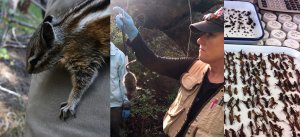Presented By: Ecology and Evolutionary Biology
EEB Thursday Seminar: The influence of temperature, productivity and food resources on biodiversity and range shifts
Christy McCain, Associate Professor and Curator of Vertebrates, University of Colorado-Boulder Dept of Ecology and Evolutionary Biology and CU Natural History Museum

Faunal and floral diversity are strongly correlated with climate. But whether the mechanistic climate-diversity link is direct through physiology, clade-scale ecological or evolutionary climatic affinities, or indirect through food resources and population sizes remains largely untested simultaneously. We assessed mammal diversity and population sizes, arthropod biomass, vegetation biomass, climate (temperature, precipitation) and productivity (NPP) across 32 sites spread among four elevational transects in the Colorado Rocky Mountains. Structural equation modeling only detected support for a direct diversity-productivity relationship. In contrast, the indirect “more individuals hypothesis” mediated through productivity’s influences on food resources was not supported. This suggests that high productivity areas represent an optimal environment whether that is due to contemporary climatic sorting or deeper-time, evolutionary underpinnings of climate during diversification.
Due to the strong climate associations of most clades, the implications of climate change to fauna and flora on mountains are predicted to be dire. But the rush to assess species’ responses to anthropogenic climate change has underestimated the importance of interannual population variability. Using population simulations across a realistic, empirically-based gradient in population variability, the frequency and magnitude of population peaks and troughs greatly impact the accuracy of our climate change response measurements regardless of taxonomic group. Based on results for measurements of population decline, local extirpation, and range shifts, several types of studies of climate change responses are not encouraged and additional sampling regimes are suggested to overcome biases associated with interannual population fluctuations.
Due to the strong climate associations of most clades, the implications of climate change to fauna and flora on mountains are predicted to be dire. But the rush to assess species’ responses to anthropogenic climate change has underestimated the importance of interannual population variability. Using population simulations across a realistic, empirically-based gradient in population variability, the frequency and magnitude of population peaks and troughs greatly impact the accuracy of our climate change response measurements regardless of taxonomic group. Based on results for measurements of population decline, local extirpation, and range shifts, several types of studies of climate change responses are not encouraged and additional sampling regimes are suggested to overcome biases associated with interannual population fluctuations.